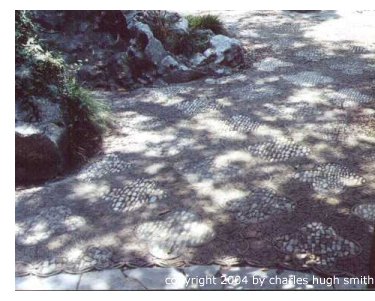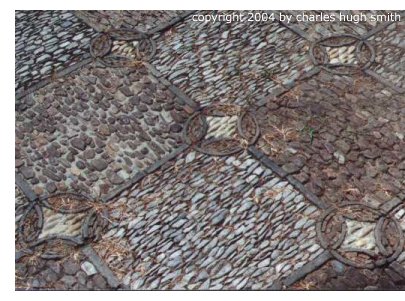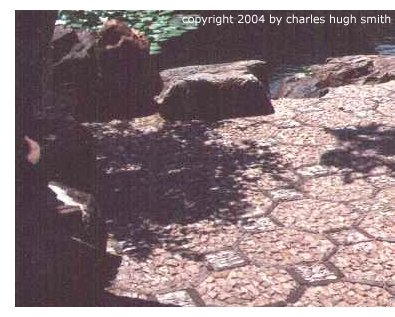

|
| back | home | |
|
Designing Minds 17: Courtyard Patterns (2000)  What do clay roofing tiles and pebbles have to do with paving a
courtyard? At first blush, not much--that is, until you've strolled through
the Wu Jiang Gardens near Shanghai, which I was fortunate enough to visit
last month.
What do clay roofing tiles and pebbles have to do with paving a
courtyard? At first blush, not much--that is, until you've strolled through
the Wu Jiang Gardens near Shanghai, which I was fortunate enough to visit
last month.
I was struck by the astonishing array of courtyard paving patterns that the Chinese masters had created with the deceptively simple elements of rounded clay roofing tiles, pebbles and bricks. While large-scale classic Japanese garden designs, such as Katsura Imperial Garden in Kyoto, typically include artfully arranged views reached by meandering walkways, the urban Wu Jiang gardens and Yu Yuan Garden in old Shanghai pack their surprises and views into a connected series of courtyards. As you wander through the maze-like courtyards, you are first impressed by the careful attention the planners paid to constructing a sense of mystery within small spaces: high walls pierced by narrow doorways, small villas, curving bridges and set-piece aggregates of natural stone are folded into the landscaping with such sublime unity that it takes a moment to realize how different each courtyard is from the previous one. 
In many cases, the courtyard was constructed around a central feature, such as a pond or rock outcropping, which is viewed from an attendant villa; in others, smaller features such as narrow bridges, small-scale landscapes and stepping stones form a composition meant to be explored on foot. Eventually you notice how the paving design differs from courtyard to courtyard, and begin to marvel at the richness of the variations achieved on a geometric theme with the simplest of materials: dark gray clay bricks, pebbles, both smooth and rough, and gray roofing tiles set into the earth so only the crescent-shaped end is visible. In one pattern, thin gray bricks form six interlocking triangles filled with rough pebbles around hexagons of embedded smooth river rocks. In another, eight curved roofing tiles have been joined into a diamond- shaped design set inside a circle; each of these occupies a corner in a grid of squares, alternately filled with rough and smooth pebbles. Some designs are formal patterns of interlocking octagons and smaller squares; others are more organic designs, such as one of curved roofing tiles in a four-leaf-clover pattern surrounded by thin hand-laid fired clay rectangles which are also buried vertically.  Others are simplicity itself: alternating squares of smooth brick and
more irregular, smaller rectangles of dark gray fired clay.
Others are simplicity itself: alternating squares of smooth brick and
more irregular, smaller rectangles of dark gray fired clay.
On occasion, a large design of the same simple materials occupies the center of the courtyard, breaking the symmetry of the pattern to great effect. In one such plan, a circle formed by thin bricks set edge to edge is differentiated from the surrounding geometry not only by shape but by the color of the smooth pebbles filling the outline of the circle. In all cases, the patterns of the courtyard paving are created not by large flat bricks or wide stones as in the West or Japan, but by small pieces of tile, brick or stones painstakingly assembled into surfaces which retains both a fine-grained texture and a large-scale formality. The surface can thus be enjoyed both at a distance--for example, upon entering the courtyard or viewed from a second-floor villa--and close at hand as you walk about the courtyard. The designers also took care to soften the formality of their complex geometric patterns by placing the hard, flat plane of the courtyard paving within the organic curves and irregular edges of natural stones and waterways. In small spaces where this was impractical, such as in entryways or passages, they broke up the linear boredom by setting the paving squares at 45-degree angles to the surrounding walls. By setting the pieces edge up, not only did the builders exploit the satisfying scale of small pieces assembled into larger patterns but they also constructed a deepset, highly durable and easily repaired surface. * * * |
||
| back | home |